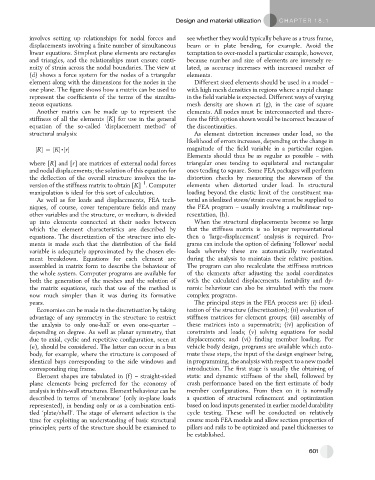Page 590 - Automotive Engineering Powertrain Chassis System and Vehicle Body
P. 590
Design and material utilization C HAPTER 18.1
involves setting up relationships for nodal forces and see whether they would typically behave as a truss frame,
displacements involving a finite number of simultaneous beam or in plate bending, for example. Avoid the
linear equations. Simplest plane elements are rectangles temptation to over-model a particular example, however,
and triangles, and the relationships must ensure conti- because number and size of elements are inversely re-
nuity of strain across the nodal boundaries. The view at lated, as accuracy increases with increased number of
(d) shows a force system for the nodes of a triangular elements.
element along with the dimensions for the nodes in the Different sized elements should be used in a model –
one plane. The figure shows how a matrix can be used to with high mesh densities in regions where a rapid change
represent the coefficients of the terms of the simulta- in the field variable is expected. Different ways of varying
neous equations. mesh density are shown at (g), in the case of square
Another matrix can be made up to represent the elements. All nodes must be interconnected and there-
stiffness of all the elements [K] for use in the general fore the fifth option shown would be incorrect because of
equation of the so-called ‘displacement method’ of the discontinuities.
structural analysis: As element distortion increases under load, so the
likelihood of errors increases, depending on the change in
½R¼½K,½r magnitude of the field variable in a particular region.
Elements should thus be as regular as possible – with
where [R] and [r] are matrices of external nodal forces triangular ones tending to equilateral and rectangular
and nodal displacements; the solution of this equation for ones tending to square. Some FEA packages will perform
the deflection of the overall structure involves the in- distortion checks by measuring the skewness of the
–1
version of the stiffness matrix to obtain [K] . Computer elements when distorted under load. In structural
manipulation is ideal for this sort of calculation. loading beyond the elastic limit of the constituent ma-
As well as for loads and displacements, FEA tech- terial an idealized stress/strain curve must be supplied to
niques, of course, cover temperature fields and many the FEA program – usually involving a multilinear rep-
other variables and the structure, or medium, is divided resentation, (h).
up into elements connected at their nodes between When the structural displacements become so large
which the element characteristics are described by that the stiffness matrix is no longer representational
equations. The discretization of the structure into ele- then a ‘large-displacement’ analysis is required. Pro-
ments is made such that the distribution of the field grams can include the option of defining ‘follower’ nodal
variable is adequately approximated by the chosen ele- loads whereby these are automatically reorientated
ment breakdown. Equations for each element are during the analysis to maintain their relative position.
assembled in matrix form to describe the behaviour of The program can also recalculate the stiffness matrices
the whole system. Computer programs are available for of the elements after adjusting the nodal coordinates
both the generation of the meshes and the solution of with the calculated displacements. Instability and dy-
the matrix equations, such that use of the method is namic behaviour can also be simulated with the more
now much simpler than it was during its formative complex programs.
years. The principal steps in the FEA process are: (i) ideal-
Economies can be made in the discretization by taking ization of the structure (discretization); (ii) evaluation of
advantage of any symmetry in the structure to restrict stiffness matrices for element groups; (iii) assembly of
the analysis to only one-half or even one-quarter – these matrices into a supermatrix; (iv) application of
depending on degree. As well as planar symmetry, that constraints and loads; (v) solving equations for nodal
due to axial, cyclic and repetitive configuration, seen at displacements; and (vi) finding member loading. For
(e), should be considered. The latter can occur in a bus vehicle body design, programs are available which auto-
body, for example, where the structure is composed of mate these steps, the input of the design engineer being,
identical bays corresponding to the side windows and in programming, the analysis with respect to a new model
corresponding ring frame. introduction. The first stage is usually the obtaining of
Element shapes are tabulated in (f) – straight-sided static and dynamic stiffness of the shell, followed by
plane elements being preferred for the economy of crash performance based on the first estimate of body
analysis in thin-wall structures. Element behaviour can be member configurations. From then on it is normally
described in terms of ‘membrane’ (only in-plane loads a question of structural refinement and optimization
represented), in bending only or as a combination enti- based on load inputs generated in earlier model durability
tled ‘plate/shell’. The stage of element selection is the cycle testing. These will be conducted on relatively
time for exploiting an understanding of basic structural course mesh FEA models and allow section properties of
principles; parts of the structure should be examined to pillars and rails to be optimized and panel thicknesses to
be established.
601

